Only imagine that you can get into a car accident when you were just crossing the street and you were hit by the car. Of course you first desire will be to get medical help in the nearest hospital. But after that you can think about compensation done to your health. In this case it would be better to contact car injury attorney who can help to win your case in the course. These Minneapolis lawyers will collect all the evidences and find the witnesses who can help to get a compensation for the injury which you got because of the car accident. One of the advantages of such law firm is that you do not have to pay anything before they win your case in the court which is great because you have to spend money on rehabilitation at the hospital. So you see that lawyers can help to find the way out of your problems if it happens to you.
Wednesday, November 26, 2008
How to find a way out of the difficult situation?
Saturday, November 15, 2008
Systems
The real intent here is not to study systems as a discipline, though more an intent to study lots of things and employ a systems perspective to foster understanding. Agreed, this requires some understanding of systems. As such, information is provided to enable one to develop a level of understanding sufficient to delve into the rest of what resides at this web site.
Every attempt will be made to avoid the major failing of "system science." In the words of Ludwig von Bertalanffy, "The student in 'system science' receives a technical training which makes systems theory -- originally intended to overcome current overspecialization -- into another of the hundreds of academic specialities."
Welcome to a journey in the realm of systems. The journey is still unfolding as this web site continues to evolve over time. Yet, even with the endless changes, there continues to be a connection, in one fashion or another, with systems. And, I continue to find that the lens which provides a systems perspective is the most revealing of understanding found to date.
The real intent here is not to study systems as a discipline, though more an intent to study lots of things and employ a systems perspective to foster understanding. Agreed, this requires some understanding of systems. As such, information is provided to enable one to develop a level of understanding sufficient to delve into the rest of what resides at this web site.
Every attempt will be made to avoid the major failing of "system science." In the words of Ludwig von Bertalanffy, "The student in 'system science' receives a technical training which makes systems theory -- originally intended to overcome current overspecialization -- into another of the hundreds of academic specialities."
Enjoy the journey!
System
The word system probably has more varied meanings than any other word in use today. The definition I have become comfortable with I owe to the late Austrian Biologist Ludwig von Bertalanffy.
A system is an entity which maintains its existence
through the mutual interaction of its parts.
The key emphasis here is "mutual interaction," in that something is occurring between the parts, over time, which maintains the system. A system is different than a heap or a collection, mostly.
This definition of a system implies something beyond cause and effect. Rather than simply A affects B, there is an implication that B also affects A. Examples of systems are particle, atom, molecule, cell, organ, person, community, state, nation, world, solar system, galaxy, and universe, in increasing levels of complexity. In truth there is only one system, "the Universe," and all other systems are really just sub-systems of this larger system. The relevant question has to do with where one chooses to draw boundaries.
Emergence
Associated with the idea of system is a principle called emergence. From the mutual interaction of the parts of a system there arise characteristics which can not be found as characteristic of any of the individual parts.
Stumbling across this as I did was most enlightening. It was probably in high school that I was first acquainted with the idea of synergy; the idea that the whole was greater than the sum of its parts. And, for all the examples ever used, emergence never really hit me until I ran into the right example. The right example just happened to be water! Amazing it took so long since there's so much of it around.
One could study hydrogen and oxygen in isolation from each other forever and never discover the characteristic of wetness. Wetness is an emergent characteristic of the mutual interaction of hydrogen and oxygen when combined to produce the molecular form called water. One has to study the system to get a true understanding of wetness. Studying the parts will not provide an appropriate understanding.
A systems view is somewhat in contradiction to the concept of analysis, which is breaking things down into smaller pieces to simplify the study. Analysis brings with it the risk of potentially loosing the most relevant characteristics of the system, and possibly developing a less than complete understanding. Yes, analysis is an important technique, and at the same time another method of study is also warranted, something I have seen called anasynthis. Anasynthis being the study of the whole, and the parts, in the hopes of developing an appropriate level of understanding.
Dynamic Modeling
Models are the things we build to help us understand things better. When dealing with concepts of reality we have as the only alternative those abstractions we develop as models, or in situations where it is simply to costly to build the real thing, we build models to help us understand. In short models are simplifications, or abstractions, of reality intended to promote understanding. Whether the models we create are good models or poor models depends on the extent to which they aid us in developing the understanding we seek. As to whether a model is correct or incorrect is probably something which will only become evident in time.
The difficulty, or I should say limiting characteristic, of most of the models we build is that they are static in nature. That is, they are models that represent a snapshot of something at a particular point in time. Yet, reality is not static. Reality is constantly changing through our interactions with it, and the interactions between all of its parts, reality is dynamic in its nature. The question arises as to how we can believe that it is possible to build static models of dynamic reality and expect them to aid our understanding to anything more than a very limited extent.
The answer to this question is provided by something call Dynamic Modeling, or as it was probably better known in a prior incarnation, Simulation. Reality operates "in" time, real time. Dynamic Modeling operates "on" time, serving to compress it in such a way that it provides us with a view of the evolution of our constructions through time.
As an example consider the interpretation we have of a bank savings account. We know that if we put money in our savings account the bank will periodically pay us interest on the money in the account. This may be represented by the following very simple model.
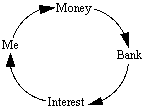
Figure 1
This diagram, a very simplistic model, says if I give Money to the Bank then the Bank will give Interest to Me. Pretty simple, yes? Yet what does this model tell us about how things change over time? Not much.
Now consider the following diagram.

Figure 2
This is what is typically called a Systems Thinking, or Causal Loop, Diagram. The intent is to add a bit more information than is found in Figure 1. If you're not familiar with these diagrams don't let it get to you. They're not as difficult to read as you might think. For addition information on reading diagrams see: Introduction to Systems Thinking.
What the diagram indicates is simply influences between various parts of the system, with indicators as to the nature of the influence being either the same (S) or opposite (O).
Figure 2 reads as follows: Money and Interest both serve to increase the Principal. Principal, acting in conjunction with Interest Rate, both serve to increase Interest. This Interest then feeds into Principal serving to increase it even more. The snowball rolling down hill at the center of the diagram indicates this is a reinforcing structure, reinforcing in that it feeds upon itself.
Figure 2 gives some additional information over what was provided in Figure 1. Some additional information in terms of how the parts of the system influence each other, yet Figure 2 still gives us little information about how the system operates "in" time.
Suppose we consider the following scenario. If I put $100 in the bank and the bank pays an interest of 6% quarterly, how much money will I have in 8 years? Yes, there is a mathematical formula by which you can calculate this. In most dynamic systems the formulas are of such complexity as to become completely unmanageable.
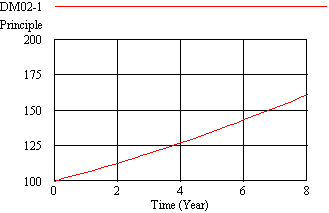
Figure 3
Figure 3 is the result of associating, or embedding, equations into the model and running it with quarterly calculations. As a result, the model indicates you would have $161.03 at the end of the 8th year.
Now suppose the bank was paying 8% interest as opposed to 6%. How would this change the result? This is presented in Figure 4, which compares the result with Figure 3. This would result in $188.45 at the end of 8 years.
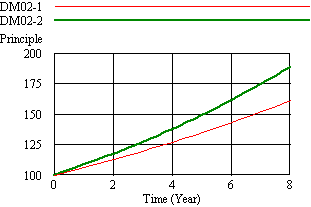
Figure 4
Now suppose I also put another $10 in the account every quarter.
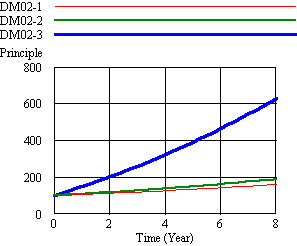
Figure 5
Figure 5 indicates that simply adding $10 a quarter to the account will produce $630.72 at the end of 8 years. A substantial increase, when compared with the result of Figure 3 and Figure 4, for a small ongoing addition to the principal.
In each of these examples the static model of the system has not changed, yet the dynamic result is markedly different in each of the examples cited.
Now let's consider an example which isn't quite as simplistic as the Interest and Principal one.
Consider a rather high profile consulting company with 120 employees. Of these 120 employees 60 are professionals and 60 are rookies in training to be professionals. The company bills their clients at a rate of $15k per month for professionals and $5k per month for rookies. Also, it takes 6 months to train a rookie to be a professional. Currently the company wants to remain at 120 employees, and since there are 5 professionals that quit each month, the company hires a new rookie for each professional that quits. Figure 6 is a systems thinking diagram of this description.
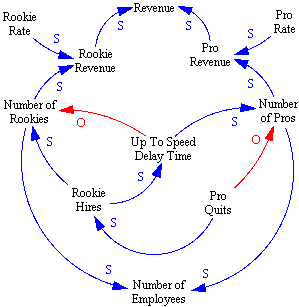
Figure 6
The overall result of this system is that it is in a steady state. The 120 employees of this company will generate $1.2 million a month in revenue, if they're all on billing, which I understand is a somewhat far fetched assumption.
Now, what happens if the Pro Quits rate jumps from 5 to 7 per month beginning in the 4th month? I don't think you're going to find a straight forward mathematical formula which will provide an indication of the implications of this change in the system operation. Plugging this change into the model in Figure 6 and running the simulation produces the following operational changes in the system.
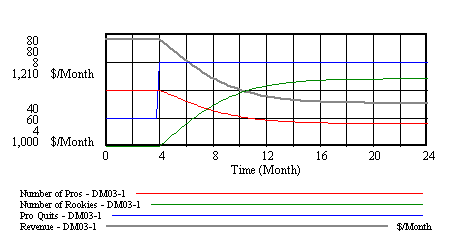
Figure 7
What Figure 7 portrays is that in month 4 Pro Quits jumps from 5 to 7. This one time change sets off a 12 month transition in the system where the number of Pros declines from 60 to 48 and the number of Rookies increases from 60 to 72. While this transition is in progress revenue drops accordingly from $1.2 M per month to $1.08 M.
This example should provide a foundation for the value of Dynamic Modeling in terms of providing a capability for seeing the time compression of reality.
Discrete Simulation
Discrete simulation is a technique where the simulation is advanced from event time to event time rather than using a continuously advancing time clock as in continuous simulation.
Suppose we consider the example of the interaction of the principle and interest associated with a savings account. This can be represented by a systems thinking diagram as follows:
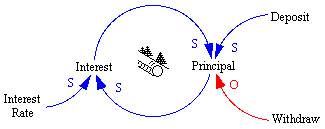
This diagram indicates that Deposits increase the Principal and Withdraws decrease the Principal. Also, the Principal interacts with the Interest Rate on some periodic basis to create Interest. The Interest then serves to increase the Principal.
If we then turn this into a 10 year simulation with the assumptions that the Principal is initially $100, there are no Deposits or Withdraws, and an Interest Rate of 5% is paid once a year it might look like this in Extend.

In the above diagram the Generator function schedules events, which in this particular example just happen to be once a year. When the event happens Interest is computed based on the Principal and the Interest Rate and is tacked on as a value for the event. The event value is extracted in the Get Value function and added to the Principal. The event itself then exits the system.
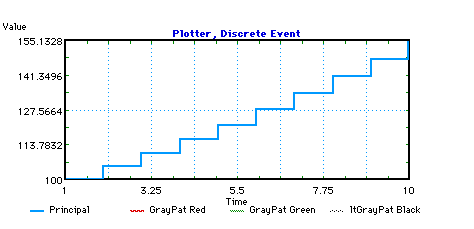
The above graph show the result of running the model for 10 years. Note that the Interest is computed and added to the Principal at the end of each year and the discrete nature of the simulation is very evident.
Updating Blog Offline
Required in writing this blog offline computer is offline at home, online at the school, to bring> 128 MB, and perseverance in writing a blog should be the main capital to develop the blog. With equipment in the combat you are ready to follow this tutorial.
actually there are many blogging software is a good offline at once free, the following list.
1.Windows Live Writer
Microsoft blogging software is made (if I know the new Microsoft would also make a good free) that made with other softaware windows live. Many fans and the people users. This software is actually a portable, but with the help of good people in the virtual universe, make the launcher .
Until now, the author can not make a portable (not yet Live Writer, which can be downloaded directly portable, so should make their own) nginstall portable who said I should update said. I love the original, to create a portable install must be first in the company. If there is a successful to make it portable please help and tell me yes!
2.Post2Blog
Applications include rival weight of WLW, the application is so sophisticated it. used this application is an application service, but then digratiskan and portablenya version prepared by the author. To create a portable, you must first installing (but this is easy, like kayaking WLW) continued from the start menu you can create portablenya.
3.ScribeFire
ScribeFire is addon (progaram additional) on broeser Mozilla Firefox (the browser, so this one mad drama). To portablenya problem we can akali using FirefoxPortable. Information about the addon and Portable Firefox, and you can see the link.
Back to ScribeFire, compared to two rivalnya Scribefire is very minimal but also very powerfull.
features that play other blogs are: QuickAds, QuickBlogging and save drafts.
4.BlogDesk
As ScribeFire, Blogdesk is also a blogging tool that simple. Blogdesk must also "make it portable" own and the author has not been successful to do it.
Because of personal experiences that the author can only use ScribeFire then I also write ScribeFire. to make it then you should install FirefoxPortable in Flashdisk, can be a long and the new firefox 3. Close Firefox "ancient" and then you open the FirefoxPortable to feel the grandeur portabilitas (Lifestyle Portable). After that, please go to this address addon ScribeFire. Downloadnya right-click button and select save as. Select a location to save the download.
After you finish downloading the file and drag it to your portable cell phone, click install and waiting until there is a command to restart Firefox. Close Firefox, and you run again so that ScribeFire installed.
Now there should be a key note at the bottom of the firefox bar, click the image. In a bizarre and the supernatural will be out of the frame where you can write your blog.
Congratulations you can now write a blog in Offline.
ScribeFire easy to use, note the tab-tab on the left, and learn the settings.
Okay, please experiment with this new toy, and safe Berblogging
10 ethical computer
10 ethical computer use:
1. Do not use a computer to harm other people
2. Do not violate the rights of the computer or another person or the
work other people's computer
3. Do not see the files - files that are not our rights
4. Do not use a computer to steal
5. Do not use a computer to give false testimony
6. Do not duplicate or use illegal software
7. Do not use the computer resources of others without the owner's
computer
8. Do not steal the intellectual property of others
Like duplicating a software and then commercialize it.
9. Consider the consequences of the program that created or computer
system designed
10. Always consider and put to respect each other when using the
computer
resource: www.beritanet.com
Thursday, November 13, 2008
Launch Jack Audio Connection Kit daemon with realtime scheduling
When Jack Audio Connection Kit is installed, it adds specific "limit" to jackuser group, into Pluggable Authentication Modules (pam).
Cf. the /etc/security/limits.conf file.
So the only need is to add the user which must need to launch the Jack Audio Connection Kit daemon with realtime scheduling into the jackuser group:
/usr/sbin/usermod -G jackuser "username"
Then, use the -R option when launching Jack Audio Connection Kit daemon:
jackd -R ...
N.B.: those instructions have been performed (at least) under Fedora 8 scheduling, with a no-root user.
Data, Information, Knowledge, and Wisdom

There is probably no segment of activity in the world attracting as much attention at present as that of knowledge management. Yet as I entered this arena of activity I quickly found there didn't seem to be a wealth of sources that seemed to make sense in terms of defining what knowledge actually was, and how was it differentiated from data, information, and wisdom. What follows is the current level of understanding I have been able to piece together regarding data, information, knowledge, and wisdom. I figured to understand one of them I had to understand all of them.
According to Russell Ackoff, a systems theorist and professor of organizational change, the content of the human mind can be classified into five categories:
- Data: symbols
- Information: data that are processed to be useful; provides answers to "who", "what", "where", and "when" questions
- Knowledge: application of data and information; answers "how" questions
- Understanding: appreciation of "why"
- Wisdom: evaluated understanding.
A further elaboration of Ackoff's definitions follows:
Data... data is raw. It simply exists and has no significance beyond its existence (in and of itself). It can exist in any form, usable or not. It does not have meaning of itself. In computer parlance, a spreadsheet generally starts out by holding data.
Information... information is data that has been given meaning by way of relational connection. This "meaning" can be useful, but does not have to be. In computer parlance, a relational database makes information from the data stored within it.
Knowledge... knowledge is the appropriate collection of information, such that it's intent is to be useful. Knowledge is a deterministic process. When someone "memorizes" information (as less-aspiring test-bound students often do), then they have amassed knowledge. This knowledge has useful meaning to them, but it does not provide for, in and of itself, an integration such as would infer further knowledge. For example, elementary school children memorize, or amass knowledge of, the "times table". They can tell you that "2 x 2 = 4" because they have amassed that knowledge (it being included in the times table). But when asked what is "1267 x 300", they can not respond correctly because that entry is not in their times table. To correctly answer such a question requires a true cognitive and analytical ability that is only encompassed in the next level... understanding. In computer parlance, most of the applications we use (modeling, simulation, etc.) exercise some type of stored knowledge.
Understanding... understanding is an interpolative and probabilistic process. It is cognitive and analytical. It is the process by which I can take knowledge and synthesize new knowledge from the previously held knowledge. The difference between understanding and knowledge is the difference between "learning" and "memorizing". People who have understanding can undertake useful actions because they can synthesize new knowledge, or in some cases, at least new information, from what is previously known (and understood). That is, understanding can build upon currently held information, knowledge and understanding itself. In computer parlance, AI systems possess understanding in the sense that they are able to synthesize new knowledge from previously stored information and knowledge.
Wisdom... wisdom is an extrapolative and non-deterministic, non-probabilistic process. It calls upon all the previous levels of consciousness, and specifically upon special types of human programming (moral, ethical codes, etc.). It beckons to give us understanding about which there has previously been no understanding, and in doing so, goes far beyond understanding itself. It is the essence of philosophical probing. Unlike the previous four levels, it asks questions to which there is no (easily-achievable) answer, and in some cases, to which there can be no humanly-known answer period. Wisdom is therefore, the process by which we also discern, or judge, between right and wrong, good and bad. I personally believe that computers do not have, and will never have the ability to posses wisdom. Wisdom is a uniquely human state, or as I see it, wisdom requires one to have a soul, for it resides as much in the heart as in the mind. And a soul is something machines will never possess (or perhaps I should reword that to say, a soul is something that, in general, will never possess a machine).
Personally I contend that the sequence is a bit less involved than described by Ackoff. The following diagram represents the transitions from data, to information, to knowledge, and finally to wisdom, and it is understanding that support the transition from each stage to the next. Understanding is not a separate level of its own. (look the pictures above)
Ex: It is raining.
Information embodies the understanding of a relationship of some sort, possibly cause and effect.
Ex: The temperature dropped 15 degrees and then it started raining.
Knowledge represents a pattern that connects and generally provides a high level of predictability as to what is described or what will happen next.
Ex: If the humidity is very high and the temperature drops substantially the atmospheres is often unlikely to be able to hold the moisture so it rains.
Wisdom embodies more of an understanding of fundamental principles embodied within the knowledge that are essentially the basis for the knowledge being what it is. Wisdom is essentially systemic.
Ex: It rains because it rains. And this encompasses an understanding of all the interactions that happen between raining, evaporation, air currents, temperature gradients, changes, and raining.
Yet, there is still a question regarding when is a pattern knowledge and when is it noise. Consider the following:
- Abugt dbesbt regtc uatn s uitrzt.
- ubtxte pstye ysote anet sser extess
- ibxtedstes bet3 ibtes otesb tapbesct ehracts
It is quite likely this sequence represents 100% novelty, which means it's equivalent to noise. There is no foundation for you to connect with the pattern, yet to me the statements are quite meaningful as I understand the translation with reveals they are in fact Newton's 3 laws of motion. Is something knowledge if you can't understand it?
Now consider the following:
- I have a box.
- The box is 3' wide, 3' deep, and 6' high.
- The box is very heavy.
- The box has a door on the front of it.
- When I open the box it has food in it.
- It is colder inside the box than it is outside.
- You usually find the box in the kitchen.
- There is a smaller compartment inside the box with ice in it.
- When you open the door the light comes on.
- When you move this box you usually find lots of dirt underneath it.
- Junk has a real habit of collecting on top of this box.
What is it?
A refrigerator. You knew that, right? At some point in the sequence you connected with the pattern and understood it was a description of a refrigerator. From that point on each statement only added confirmation to your understanding.
If you lived in a society that had never seen a refrigerator you might still be scratching your head as to what the sequence of statements referred to.
Also, realize that I could have provided you with the above statements in any order and still at some point the pattern would have connected. When the pattern connected the sequence of statements represented knowledge to you. To me all the statements convey nothing as they are simply 100% confirmation of what I already knew as I knew what I was describing even before I started.
References:
- Ackoff, R. L., "From Data to Wisdom", Journal of Applies Systems Analysis, Volume 16, 1989 p 3-9.
- Gadomski, Adam Maria, Information, Preferences and Knowledge, An Interesting Evolution in Thought
- Sharma, Nikhil, The Origin of the Data Information Knowledge Wisdom Hierarchy